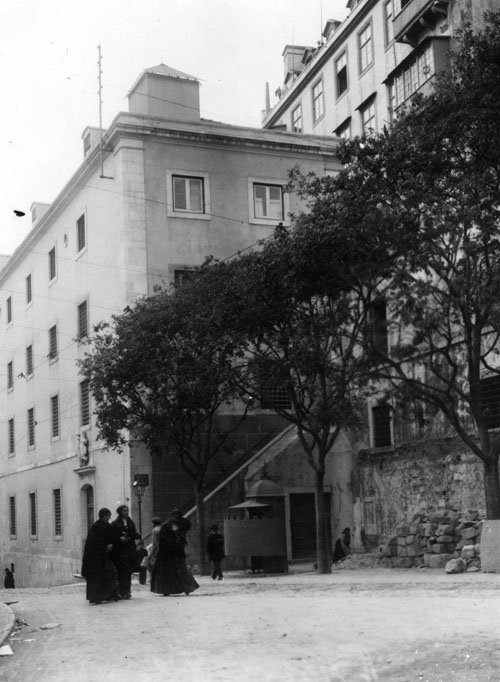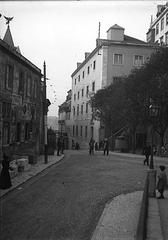
Cadeia do Aljube: Visiting Hours, Tickets, and Historical Significance in Lisbon
Date: 14/06/2025
Introduction
Cadeia do Aljube, located near the iconic Sé Cathedral in Lisbon, is a powerful symbol of Portugal’s turbulent past and enduring fight for freedom. Originally an ecclesiastical prison dating back to the 12th century, its name derives from the Arabic “al-jubb” meaning “cistern” or “well.” Over centuries, Aljube transformed from a religious detention center into a notorious political prison under the Estado Novo dictatorship (1933–1974). Today, it houses the Museu do Aljube – Resistência e Liberdade, which commemorates the struggle against authoritarianism and the resilience of those who fought for democracy.
This comprehensive guide covers the museum’s historical evolution, practical visitor details—including hours, tickets, and accessibility—nearby attractions, and essential tips to enrich your visit. For official updates and resources, consult the Museu do Aljube official website, as well as tourism platforms like Visit Lisboa and Lisbon Portugal Tourism.
Table of Contents
- Historical Overview
- Visiting Cadeia do Aljube
- Exhibition Highlights
- Nearby Attractions
- Frequently Asked Questions
- Contact Information
- Conclusion and Final Tips
- References and Further Reading
Historical Overview
Origins and Early Function
Cadeia do Aljube’s origins date to the 12th century, with its name reflecting Lisbon’s Moorish heritage (Museu do Aljube). Initially serving as an ecclesiastical prison, it detained those accused of religious offenses and moral transgressions. By the 16th century, it became integrated into Lisbon’s secular prison system, holding individuals awaiting trial by religious and civil courts (Visit Lisboa).
After the devastating 1755 earthquake, the prison was rebuilt and continued to function as a penal institution, later becoming a women’s prison in the 19th century (Viver Lisboa).
Transformation into a Political Prison
Aljube’s darkest chapter began in the 20th century, when it was repurposed as a political prison under the Estado Novo dictatorship. The regime detained, interrogated, and tortured political dissidents, activists, and intellectuals—including notable figures such as Mário Soares and Álvaro Cunhal (Lisbon Portugal Tourism). Prisoners faced harsh conditions, psychological and physical abuse, and profound isolation.
The prison closed in 1965 and was transformed into a museum in 2015, marking the anniversary of the Carnation Revolution and Portugal’s democratic transition (Visit Portugal).
Life Inside the Prison
Life within Cadeia do Aljube was grim. Inmates endured cramped, poorly ventilated cells, long periods of solitary confinement, and constant surveillance by the secret police (PIDE). The personal stories and testimonies of those imprisoned here are preserved throughout the museum, offering visitors a direct connection to the lived experience of political resistance.
Visiting Cadeia do Aljube
Location and Accessibility
- Address: Rua de Augusto Rosa, 42, 1100-059 Lisboa, Portugal
- District: Santa Maria Maior (Sé), centrally located and within walking distance of major Lisbon landmarks (Trek Zone).
Getting There
- Metro: Terreiro do Paço (Blue Line) and Baixa-Chiado stations are within a 10-minute walk.
- Tram: Tram 28 stops at Sé, just steps from the museum.
- Bus: Lines 737 and 206 serve the area.
- Walking: The museum is easily reached on foot from downtown Lisbon.
- Parking: Limited in the historic center; public transport is recommended.
For updated public transport schedules, visit the Carris website.
Opening Hours and Tickets
- Tuesday to Sunday: 10:00 AM – 6:00 PM
- Closed: Mondays, January 1st, May 1st, December 24th, December 25th
- General Admission: €3.00
- Students, Seniors (65+), Youth (13–18): €1.50
- Children under 12: Free
- Lisbon Card holders: Free
- Free admission: First Sunday of each month (check for updates)
- Tickets: Purchase on-site or online at the official website.
Museum Facilities and Accessibility
- Reception and Ticket Office: Entry point for tickets and information.
- Cloakroom: Available for personal belongings.
- Restrooms: Accessible facilities.
- Museum Shop: Books, souvenirs, and educational materials.
- Café: Light snacks and drinks with panoramic city views.
- Wheelchair Access: Most exhibition spaces accessible via ramps and elevators; some original prison areas may have restricted access.
- Signage: Bilingual (Portuguese and English); some materials in other languages.
- Audio Guides: Available in multiple languages for a small fee.
- Guided Tours: In Portuguese and English; advance booking recommended for groups (Museu do Aljube Contact).
Exhibition Highlights
- Permanent Exhibition: Spans three floors, focusing on political oppression, censorship, clandestine resistance, and colonial wars (Lisbon Portugal Tourism).
- Original Prison Cells: Preserved spaces provide an authentic experience of incarceration.
- Personal Testimonies: Multimedia interviews and accounts by former prisoners.
- Artifacts: Documents, photographs, banned literature, and resistance materials.
- Temporary Exhibitions: Regularly updated, exploring themes of democracy and human rights (getLISBON; lisboacool).
- Café and Reflection Area: Top floor café with panoramic views; auditorium for events.
Visitor Experience and Tips
- Recommended Duration: 1.5–2 hours for a thorough visit.
- Photography: Allowed in most areas (no flash/tripods); observe signage.
- Best Visiting Times: Early mornings and late afternoons on weekdays for a quieter experience.
- Emotional Content: Some exhibits are intense; use café and reflection spaces for breaks.
- Dress Comfortably: Cobblestone streets and uneven floors—wear suitable footwear.
- Children: Content is best suited for ages 12+; parental discretion advised.
- Language: Most staff speak English; all main information is bilingual.
Nearby Attractions
- Lisbon Cathedral (Sé de Lisboa): Two-minute walk.
- Igreja de Santa Luzia: Five-minute walk.
- São Jorge Castle: Ten minutes on foot.
- Arco da Rua Augusta and Praça do Comércio: Easy walk from the museum.
- Alfama District: Ideal for a walking tour of Lisbon’s oldest neighborhood.
Frequently Asked Questions
Q: Where can I buy Cadeia do Aljube tickets?
A: Tickets are available at the museum’s reception or online through the official website.
Q: Is the museum wheelchair accessible?
A: Most main areas are accessible, but some prison cells have limited access due to the building’s historic structure.
Q: Are guided tours available?
A: Yes, in Portuguese and English; advance booking is recommended.
Q: What are the best times to visit to avoid crowds?
A: Early mornings and late afternoons on weekdays.
Q: Is photography allowed in the museum?
A: Non-flash photography is permitted in most areas; restrictions apply to some exhibits.
Contact Information
- Address: Rua de Augusto Rosa 42, 1100-059 Lisboa, Portugal
- Phone: +351 215 818 535
- Email: [email protected]
- Official Website: Museu do Aljube
Conclusion and Final Tips
Cadeia do Aljube offers an immersive, moving journey through Portugal’s fight for democracy and human rights. Its well-preserved prison spaces, rich multimedia exhibits, and central location in Lisbon make it a must-visit for anyone interested in history, political heritage, or cultural exploration. Allocate at least 1.5–2 hours to fully appreciate the museum, and consider combining your visit with a tour of the Alfama district and nearby landmarks.
For up-to-date information on opening hours, ticketing, and special exhibitions, consult the Museu do Aljube official website. Enhance your experience by downloading the Audiala app for audio tours and insider tips. Stay connected via social media for news on events and educational programs. Take the opportunity to reflect on the enduring values of resistance, freedom, and human rights during your visit.
References and Further Reading
- Museu do Aljube official website
- Lisbon Portugal Tourism – Museu do Aljube Guide
- getLISBON – Museum Aljube
- Trek Zone – Cadeia do Aljube
- Visit Lisboa – Museu do Aljube
- Viver Lisboa – Antiga Cadeia do Aljube
- codandham.com – Aljube Museum: Things to Know Before Visiting
- lisboacool – Aljube Museum
- Carris Public Transport



























































